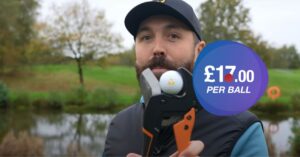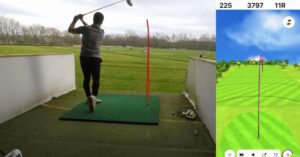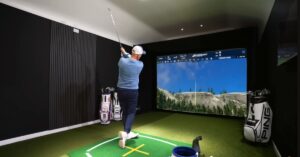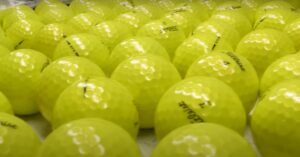Does 1 Degree Lie Angle Make Difference In Golf Shots? [Explained]
In the realm of golf, the smallest adjustments can yield substantial improvements in performance. One such minute yet impactful modification lies in the lie angle of a golf club. Now the question is- Does a 1-degree lie angle difference make an impact on your golf shots?
In short, Yes, a 1-degree lie angle difference can have an impact on your golf shots. It can affect the direction and trajectory of the ball, potentially leading to inaccurate shots.
Join us as we explore lie angles in-depth. Discover how they impact your golf performance, the effects of improper angles, and the importance of custom fitting. Understand the significance of that one degree, crucial for winning shots.
![Does 1 Degree Lie Angle Make Difference In Golf Shots? [Explained] 1 does 1 degree lie angle make difference](http://giftedgolfers.com/wp-content/uploads/2023/05/image-112-1024x538.png)
What is Lie Angle In Golf Clubs?
The lie angle in golf clubs refers to the angle between the shaft and the ground at the address. It affects shot direction and accuracy.
If the lie angle is too upright, shots may veer left (for right-handed golfers). If it’s too flat, shots can go right (for right-handed golfers).
Properly fitting the lie angle based on a golfer’s height and swing characteristics ensures the club sits flush on the ground, promoting accuracy.
Adjustments can be made by bending the hosel. Club fitting sessions help determine the correct lie angle.
How does a 1-degree lie angle difference affect golf shots?
The lie angle of a golf club is important for shot accuracy and consistency, and a difference of just 1 or 2 degrees can have a significant impact on your game.
Choosing the correct lie angle for your swing can improve your performance on the course. Here is a quick table-
| Factors | 1-Degree Variation | 2-Degree Variation |
| Shot Direction | Can deviate by 4-5 yards | Can deviate by 8-10 yards |
| Impact on Distance | Minimal | Moderate |
| Impact on Accuracy | Noticeable | Significant |
1-Degree Variation
A 1-degree difference in lie angle can lead to noticeable effects on your shots. Shot direction can deviate by approximately 4-5 yards from the intended target.
This means that a shot that would have landed on the fairway may end up in the rough or even out of bounds.
While the impact on distance is minimal, the change in shot direction can still have a significant effect on your game.
2-Degree Variation
With a 2-degree lie angle difference, the effects become even more pronounced. Shot direction can deviate by approximately 8-10 yards from the intended target.
This significant deviation can result in shots ending up in undesirable positions on the golf course, affecting your ability to attack the pin or navigate hazards.
Moreover, the impact on distance becomes more moderate, as the clubface’s contact with the ball is altered due to the lie angle variation.
Accuracy is noticeably affected, making it more challenging to consistently hit your targets.
What happens if your lie angle is too flat?
![Does 1 Degree Lie Angle Make Difference In Golf Shots? [Explained] 2 image 113](http://giftedgolfers.com/wp-content/uploads/2023/05/image-113-1024x574.png)
In the world of golf, lie angle plays a crucial role in shot accuracy and consistency.
When your lie angle is too flat, it can have significant consequences on your game.
Clubface Opens
When the lie angle is too flat, the toe of the club is more likely to hit the ground first during impact.
This causes the clubface to open at impact, resulting in a shot that pushes to the right (for right-handed golfers) and to the left for left-handed golfers.
The open clubface can lead to slices and a loss of control over the direction of the shot.
Golfers may struggle with consistently hitting the target due to the lack of face control caused by the flat lie angle.
Reduced Accuracy and Distance
A flat lie angle can also have an adverse effect on accuracy and distance. When the toe strikes the ground first, it can create a glancing blow or a loss of power during impact.
This can result in shots that lack the desired distance and may fall short of the intended target.
Golfers may find themselves consistently coming up short on approach shots or struggling to reach par-5 greens in regulation.
The reduced efficiency in transferring energy to the ball due to a flat lie angle can hamper both accuracy and distance.
Inconsistent Ball Flight
Consistency is crucial in golf, and a flat lie angle can lead to inconsistent ball flight patterns.
When the lie angle is not properly adjusted, golfers may experience variations in shot direction and ball flight.
Shots may veer unpredictably to the right or left, making it challenging to accurately gauge distances and target alignment.
Inconsistency in ball flight due to a flat lie angle can introduce a high level of unpredictability to a golfer’s game, leading to frustration and difficulty in achieving consistent results.
Common Lie Angle Issues And Their Consequences
When it comes to golf club fitting, getting the right lie angle is essential for optimal performance.
Lie angle refers to the angle between the club’s sole and the shaft, and any deviation from the correct lie angle can have significant consequences on your shots.
Flat Lie Angle
A flat lie angle occurs when the toe of the club is lower than the heel at the address. This can lead to the heel of the club striking the ground first during impact.
The consequence of a flat lie angle is an open clubface, causing shots to push to the right (for right-handed golfers).
This issue can result in slices, lack of distance, and overall inconsistency in ball flight.
Upright Lie Angle
Conversely, an upright lie angle is when the heel of the club is lower than the toe at the address. This causes the heel to strike the ground first, resulting in a closed clubface.
![Does 1 Degree Lie Angle Make Difference In Golf Shots? [Explained] 3 image 111](http://giftedgolfers.com/wp-content/uploads/2023/05/image-111-1024x608.png)
The consequence of an upright lie angle is shots that tend to veer to the left (for right-handed golfers).
Hooked shots, reduced distance, and difficulty in controlling trajectory can all be attributed to an upright lie angle.
Inconsistent Lie Angles
Consistency in lie angles is crucial for consistent shot dispersion. If your clubs have varying lie angles, your shots will spread out more widely to the left and right of your target.
Inconsistent lie angles can lead to unpredictable ball flight patterns, making it challenging to gauge distance and accuracy.
It’s essential to ensure uniformity in lie angles across your set of clubs to achieve more consistent shot dispersion.
Importance Of Custom Club Fitting For Optimizing Lie Angle
Custom club fitting, including optimizing the lie angle of golf clubs, is crucial for golfers to achieve their maximum potential on the course.
The lie angle refers to the angle between the club’s shaft and the ground when the club is properly aligned at the address. Here’s why custom club fitting for optimizing lie angle is important:
Alignment and Accuracy
The lie angle directly influences how the clubhead interacts with the ground at impact.
If the lie angle is incorrect, the clubface may not be square to the target line at impact, leading to misaligned shots.
By custom-fitting the lie angle, golfers can ensure that the clubface is properly aligned at impact, resulting in improved accuracy and consistency.
Impact on Ball Flight
The lie angle affects the direction and shape of the ball’s flight. If the lie angle is too upright (too flat), it can cause the ball to veer to the left (right) for right-handed golfers.
A proper lie angle helps promote a more neutral ball flight, reducing the likelihood of slicing or hooking the ball.
Swing Mechanics
Each golfer has unique swing mechanics and posture, including the way they set up the ball.
The lie angle needs to complement these factors to enable the golfer to achieve the optimal swing path and impact position.
Custom club fitting considers a golfer’s swing characteristics, such as their height, arm length, posture, and swing plane, to determine the most suitable lie angle for their clubs.
Consistency and Feel
When the lie angle is correctly fitted, golfers experience improved consistency in their ball striking.
The correct lie angle allows the clubhead to impact the ball with the center of the clubface, resulting in better energy transfer and a more solid feel at impact.
This consistency and improved feel contribute to better distance control and overall shot performance.
Injury Prevention
Incorrect lie angles can lead to compensations in the swing mechanics, potentially causing strain or injury.
For example, if the lie angle is too upright, it may force the golfer to reach for the ball, causing excessive stress on the back and shoulders.
Custom club fitting helps ensure that the lie angle promotes a more natural and efficient swing motion, reducing the risk of injuries.
FAQs
In this FAQ section, we tackle some prevalent questions about the effect of a 1-degree lie angle change on various aspects of a golf shot. Let’s dive right in.
What impact does a 1-degree lie angle adjustment have on ball flight?
A 1-degree lie angle adjustment can shift the direction of your shot by approximately 4-5 yards, which can significantly impact your ball’s flight and accuracy.
Can a 1-degree lie angle change improve shot accuracy?
Yes, adjusting the lie angle by 1 degree to better match your swing can improve shot accuracy by ensuring the clubface makes more square contact with the ball.
Can a 1-degree lie angle variation lead to inconsistent shot dispersion?
Absolutely. A variation in lie angle, even as small as 1-degree, can lead to inconsistent shot dispersion, affecting the spread of your shots to the left and right of the target.
Final Words
While it might seem minor, a 1-degree lie angle difference can indeed make a significant impact on your golf shots.
Therefore, understanding the importance of the lie angle and getting a custom club fitting is paramount.
After all, golf is a game of precision and accuracy, and every single degree matters!

![how many dimples are on a golf ball? [Science behind Dimples] how-many-dimples-are-on-a-golf-ball](https://giftedgolfers.com/wp-content/uploads/2023/01/how-many-dimples-are-on-a-golf-ball-300x157.jpg)



